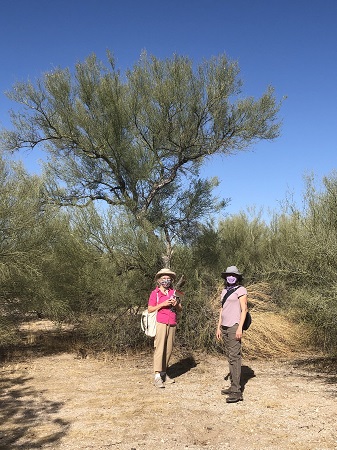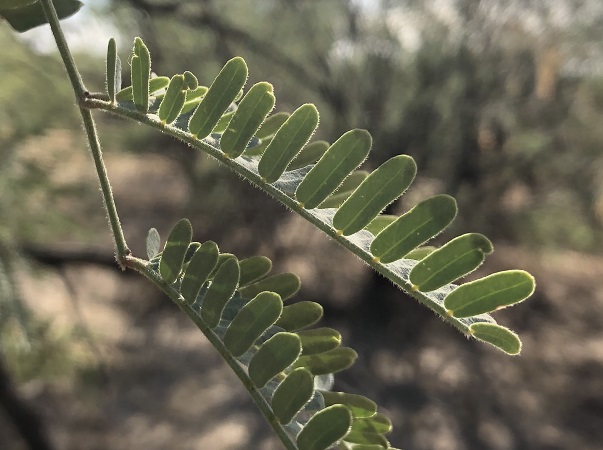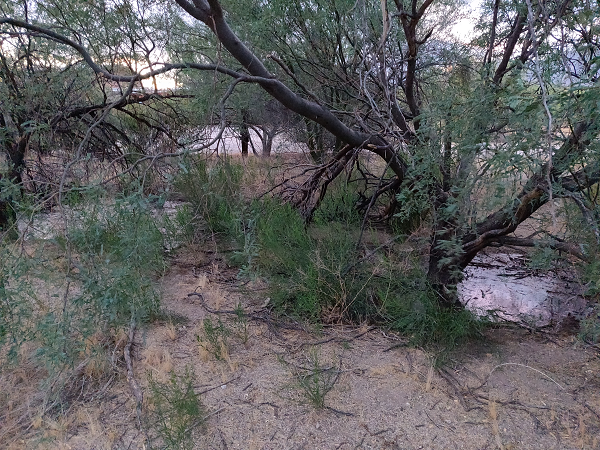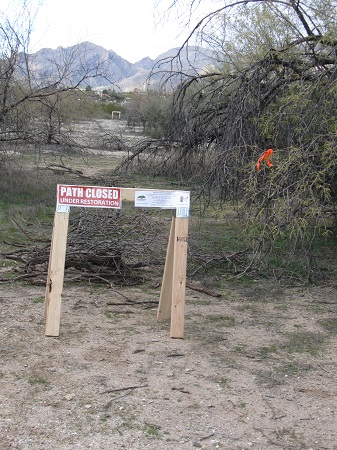Friends of Rio Vista distributes bimonthly bulletins via email and publishes key information from these bulletins here. To start receiving our bulletins, sign up here.
In this issue, we focus on updates from our partners about the long-term survey of plants in the park and about Rio Vista’s irrigation system. We also highlight the contribution of three volunteers to keeping “rogue” trails closed. Thank you so much for your support for protecting and enhancing the natural assets of Rio Vista.
Persistent Plants in the Park: Update from the Arizona Native Plant Society

Suzie Husband, co-coordinator of the Arizona Native Plant Society plant survey in the park and Friends of Rio Vista board member, contributed this update:
The amazing Sonoran Desert plants that live in Rio Vista Natural Resource Park are surviving in spite of the lack of moisture. The park supports a surprising number and variety of plants: trees, shrubs, grasses, vines, forbs, and even parasites make their homes there. In cooperation with the Rio Vista Conservation Project, volunteers from the Tucson Chapter of the Arizona Native Plant Society (AZNPS) conducted two plant surveys in the summer and fall of 2020. The dry summer survey was carried out in May and June, in anticipation of our annual monsoon, so that the changes before and after the summer rains could be documented. Unfortunately, the monsoon rains were not plentiful this year, and much-hoped-for fall and winter rains did not materialize, either. From October 1, 2020, to March 2, 2021, a mere 1.43 inches of rainfall were reported at the park, compared with 5.64 inches during the same period a year ago.
Ten volunteers spent more than 35 hours searching for and identifying plants during the two surveys. Even with our scant rainfall, the fall survey added 42 new plants to the park list, bringing the total to an impressive 108 plants identified to family and 77 plants identified to genus and species. The growing plant list will be used to identify conservation targets for the Rio Vista conservation plan. Links are here for the Dry Summer Plant List and the Fall Plant Survey.

The spring survey is now under way. Given that we are still lacking in moisture, observing the botanical activity will be interesting and instructive. What reserves and adaptations will these tough desert plants draw on?
Many thanks to the AZNPS volunteers and to co-coordinator Melanie Campbell-Carter for their commitment to the plant survey.
Where’s the Water? Update from Tucson Parks and Recreation
For all of us who love Rio Vista Natural Resource Park, seeing the effects of the long drought on native vegetation is heartbreaking. Mesquites and palo verdes struggle. The unauthorized (“rogue”) paths that we blocked with such high hopes haven’t filled with understory plants. Our thoughts turn to the park’s irrigation system. We know it’s there, but is it working? How is it maintained? What can we do to support this lifeline of water?
Recently, a Friends of Rio Vista representative and several park supporters met with City of Tucson staff to ask these questions. Dominic Rullo, parks irrigation supervisor for Tucson Parks and Recreation, had answers for us. Dominic oversees the irrigation systems in all of Tucson’s 128 city parks and supervises a team of seven irrigation specialists. At Rio Vista, he works with Ann Jefferson, the parks area supervisor, and the maintenance crew, coordinated by Richard Langdon, to keep the water flowing. Dominic evaluates the park’s entire system every year.
Thirteen years ago, the Rio Vista irrigation system was installed, using reclaimed water. Within the park is a central controller, which is tied to a citywide irrigation network. Through the computer and the weather station that regulate this larger system, the controller adjusts Rio Vista’s output daily to respond to the weather forecast. Desert trees in the park’s natural area are watered twice a week. The run time for each tree depends on the controller’s on-site measurements of evapotranspiration (evaporation from the land surface plus transpiration from plants). The turf on the west side of the park is on a different watering schedule and delivery method.

But what about malfunctions? The irrigation system has flow sensors that can detect major breaks but not, say, one malfunctioning spaghetti port. If a big break occurs, the local irrigation station shuts down and an alarm goes off. The report of the break is read the next business day. For malfunctions at the level of emitters, sprinklers, and laterals, we can help by reporting them to Tucson Parks and Recreation. Eventually, we hope to have a reporting form that will make this problem solving more systematic. For the time being, you can e-mail us, and we’ll pass the message along to Tucson Parks and Recreation staff.
Dominic sent us the as-built plans for the Rio Vista irrigation system. We can use these not only to identify problems with the system (for example, leaks) but also to determine where we can effectively plant new vegetation and reshape the land to harvest rainwater. For ecosystem enhancement, Dominic recommends choosing native desert trees that require little maintenance.
Many thanks to Dominic, Ann, and Richard, as well as to Irene Ogata (urban landscape manager at Tucson Water) and to Sean Nicholson and Mike Hayes at Tucson Parks and Recreation.
A Hard Year for Sawhorses: Update from Our Volunteers

Sun and wind have taken their toll on the sawhorses that Tucson Parks and Recreation provided as barriers for rogue trails closed through the Rio Vista Conservation Project. Friends of Rio Vista volunteers Anne Watson, Ann Cooper, and Robert Watson have generously donated their time and skill to repair sawhorses that have fallen apart. Replacement signs are in the works. Thank you, Anne, Ann, and Bob!
